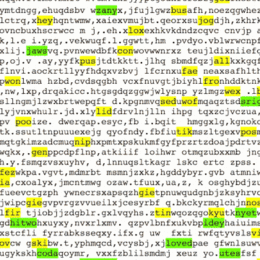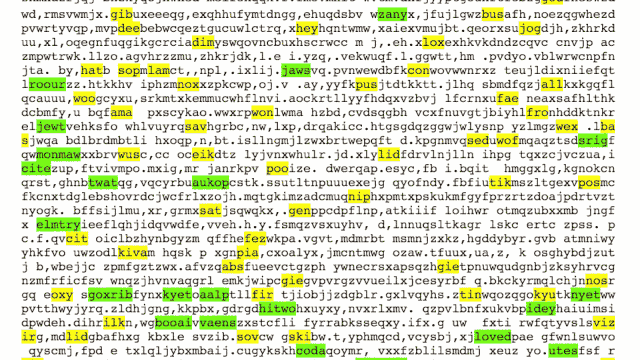How Do You Design A UX For Infinity?
For the fellow who became Jorge Luis Borges’s “Library of Babel” into a web app, this isn’t an idle question 7:00 AM
someplace within the universe, there’s a shelf of neatly geared up books with titles fabricated from nonsense. any such books incorporates 410 pages of uncapitalized English words strung collectively in no intelligible order. On web page 26 of this particular e book, about halfway down, bookended between “holons” and “linkman“, is a 26-word couplet that my four-year-old daughter will attempt to recite in her preschool’s Christmas pageant. somewhere else, on a different shelf, is some other book: this one accommodates an exact transcription, right down to the syllable, of how my daughter will adorably mangle these 26 phrases onstage when her cue arrives.
If this situation sounds familiar, it’s since the 20th-century Argentine author Jorge Luis Borges imagined it in his mindbending brief story “The Library of Babel”:
The universe (which others call the Library) consists of an indefinite and most likely infinite choice of hexagonal galleries… The Library is whole and that its shelves register all of the possible mixtures of the twenty-unusual orthographical symbols (a host which, although extraordinarily huge, isn’t endless): the whole lot… the proper story of your death, the interpretation of each guide in all languages, the interpolations of each guide in all books.
It’s a philosophically dizzying piece of literature. but what if it have been actual—what if anyone designed a digital product that faithfully replicates Borges’s Library?

Novelist Jonathan Basile did simply that. when I wrote “someplace within the universe,” I meant it literally: Basile’s model of the Library actually exists on his residence computer in Brooklyn, ny. other publications have noted the spectacular programming that went into realizing this mission. but I was more inquisitive about Basile’s UX considering. If just right design is all about embracing constraints, what are the constraints for the design drawback of “displaying every that you can imagine e book on demand”?
Others have tried to instantiate the Library online, however Basile’s version stands out for its stylish design, from the medieval-taking a look illustrations of the hexagonal rooms right all the way down to the fonts (“the texts would all have the very same dimensions in accordance Borges, so I knew they’d seem easiest in monospace,” Basile says).
but Basile didn’t cease there. His Library comes full with an onboarding expertise (or “reference hex”, as he calls it), simple-English interactions (that you would be able to browse, search, or shuffle), and even a standard “breadcrumb” navigation scheme (which you can view particular person pages or zoom inside and out to bookshelves, walls, or rooms).
“The browse page is the anchor of the person experience. It makes the person almost really feel like they’re interacting with an actual library,” Basile explains. “i needed to create a sense of physical structure in the user’s thoughts by using visually representing the hexagons, walls, cabinets, books and pages in an internally constant way—making it as straightforward as imaginable to look where you ‘are’ in the library. in any other case it’d all really feel very skinny, or like a prank—you wouldn’t get a sense of the vastness.”

the truth that each conceivable permutation of textual content in Basile’s Library already exists creates a consumer expertise that’s intentionally antagonistic to everything we expect we would like out of digital interactivity. looking the Library by myself in the course of the night—typing in, say, sentences from my deceased father’s journal, the GPS coordinates of my childhood residence, or the birthdates of my children—felt palpably uncanny. I literally received dizzy a number of occasions.
Basile can relate. “I hoped that engaged on this project would lead me to be very perplexed about existence and nonexistence,” he says, with out an iota of irony. the same is correct for his person remarks. “I heard from one one that stated that I’ve destroyed humanity and questioned why must anybody ever trouble to make or do the rest ever again,” he admits. “i tried to reassure him…i am hoping he’s rediscovering goal in his existence.”
If which you can keep below the Library’s spell lengthy sufficient for the Sartrean nausea to subside, something richer than mere “pleasure” begins to emerge from Basile’s UX design. “along with this initial reaction of ‘staring into the abyss’ that I hear about, there’s also a playful feeling that a lot of people get too,” he says. His Library offers lighthearted prognosis tools that let users toy with the Library’s galaxies of gibberish. as an instance, an “Anglishize” function highlights any real words that occur to emerge in the reams of noise. using it feels somewhat like peering into a Hubble ultra Deep box picture of the English language. (for example: do you know “booai” is a Scrabble-legal phrase? Me both. Thanks, Library of Babel!)
according to Basile, this sort of consumer-experiential ouroboros—through which dread and pleasure feed backwards and forwards on every other—will pay homage to Borges’s own literary model. “It’s roughly bleak and darkish, however it has a beautiful sense of humor and could be very open about infinity in a way that can be very liberating in the event you’re keen to chuckle with him, moderately than simply be terrified,” Basile says. I agree. The source code to a greater model of Basile’s design already without a doubt exists inside the Library’s personal confines—however so far as I’m involved, there’s no want to go searching for it.
quick company , learn Full Story
(61)










